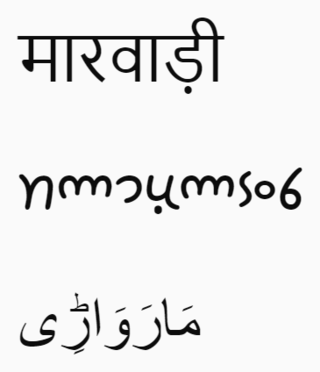Related Research Articles
Bihari is a group of the Indo-Aryan languages. The Bihari languages are mainly spoken in the Indian states of Bihar, Jharkhand, West Bengal and Uttar Pradesh and also in Nepal. The most widely spoken languages of the Bihari group are Bhojpuri, Magahi and Maithili.

Marwari is a Rajasthani language spoken in the Indian state of Rajasthan. Marwari is also found in the neighbouring states of Gujarat and Haryana, some adjacent areas in Eastern parts of Pakistan, and some migrant communities in Nepal. With some 7.8 million or so speakers, it is one of the largest varieties of Rajasthani. Most speakers live in Rajasthan, with a quarter-million in Sindh and a tenth of that number in Nepal. There are two dozen dialects of Marwari.

The Bhil languages are a group of Indo-Aryan languages spoken by around 10.4 million Bhils in western and central India as of 2011. They constitute the primary languages of the southern Aravalli Range in Rajasthan and the western Satpura Range in Madhya Pradesh, northwestern Maharashtra, and southern Gujarat. According to the 52nd report of the commissioner for linguistic minorities in India, Ministry of Minority Affairs, Bhili is the most commonly spoken language of the district of Dadra and Nagar Haveli constituting 40.42% of its total population. Bhili speakers are also significant in the states of Gujarat (4.75%), Madhya Pradesh (4.93%) and Rajasthan (4.60%).
Pardhi is a Hindu tribe in India. The tribe is found mostly in Maharashtra and parts of Madhya Pradesh however small numbers can be found in Gujarat and Andhra Pradesh. The word Pardhi is derived from the Marathi word ‘Paradh’ which means hunting and Sanskrit word ‘papardhi’ which means hunting or the game to be hunted. In some parts of India Pardhis are known as Meywarees. They also have various other names like Advichincher, Phans Pardhi, Phanse Pardhi, Langoli Pardhi, Bahelia, Bahellia, Chita Pardhi, Shikari, Takankar, Takia Pardhi. Pardhi tribe is divided in groups like Vaghri Pardhi and Phase Pardhi. These are further divided into subgroups like Pal Pardhi, Gav Pardhi, Takankar, Takari. Widely found surnames among them include Chauhan (Chavan), Rathod and Solanke.

Tamang is a term used to collectively refer to a dialect cluster spoken mainly in Nepal, Sikkim, West Bengal (Darjeeling) and North-Eastern India. It comprises Eastern Tamang, Northwestern Tamang, Southwestern Tamang, Eastern Gorkha Tamang, and Western Tamang. Lexical similarity between Eastern Tamang and other Tamang languages varies between 81% to 63%. For comparison, lexical similarity between Spanish and Portuguese, is estimated at 89%.

Teejan Bai is an exponent of Pandavani, a traditional performing art form, from Chhattisgarh, in which she enacts tales from the Mahabharata, with musical accompaniments.
Phom is a Sino-Tibetan language spoken by the Phom people of Nagaland, north-eastern India. Its speakers inhabit 36 villages in Longleng District (Ethnologue).

Zeme is a Sino-Tibetan language spoken in northeastern India. It is one of the dialects spoken by the Zeme Naga, the other being Mzieme.
Rengma, or Southern Rengma, is an Angami–Pochuri language spoken in Nagaland, India.
Yimkhiungrü, also Yachumi (Yatsumi) in Sümi, is a Sino-Tibetan language spoken in northeast India by the Yimkhiung Naga people. It is spoken between Namchik and Patkoi in Shamator District, eastern Nagaland, India. Yimkhiungrü language has more than 100,000 speakers and is used in over 100 villages and towns.
Pauri Bareli is a Bhil language of India. It is close to two other languages called Bareli, Rathwi and Palya, as well as to Kalto, but is not mutually intelligible with them.
Pochuri, or Pochuri Naga, is a Naga language spoken in Nagaland, India.
Rathwi Bareli is a Bhil language of India, spoken mainly in Gujarat. It is close to two other languages called Bareli, but not mutually intelligible with them. It has 81%–93% lexical similarity with Rathwi Bareli dialects, 67%–73% with Palya Bareli and 68%–79% with Pauri Bareli.
Bauria is a Bhil language of India.
Spurious languages are languages that have been reported as existing in reputable works, while other research has reported that the language in question did not exist. Some spurious languages have been proven to not exist. Others have very little evidence supporting their existence, and have been dismissed in later scholarship. Others still are of uncertain existence due to limited research.

The Bengali–Assamese languages is a grouping of several languages. This group belongs to the Eastern zone of Indo-Aryan languages. The languages in this group as per Glottolog includes Assamese, Bengali, Bishnupriya, Chakma, Chittagonian, Hajong, Kharia Thar, Kurmukar, Lodhi, Mal Paharia, Noakhailla, Rajbangshi, Rohingya, Sylheti, Tangchangya and Surjapuri.
The Chaddi Baniyan Gangs are criminal groups operating in parts of India. Gang members perform attacks while wearing only their underwear, which is the source of their name. In addition to wearing undergarments, members wear face masks and cover themselves in oil or mud to protect their identities.
Girish Y. Prabhune is an Indian social worker and social activist known particularly for his work towards upliftment of the nomadic Pardhi community and their children since 1970. He was conferred the Padma Shri in 2021 in Social Work category.
References
- ↑ Pardhi at Ethnologue (25th ed., 2022)
- ↑ "Statement 1: Abstract of speakers' strength of languages and mother tongues - 2011". www.censusindia.gov.in. Office of the Registrar General & Census Commissioner, India. Retrieved 7 July 2018.
- ↑ "Kurux". Ethnologue. Retrieved 11 July 2018.